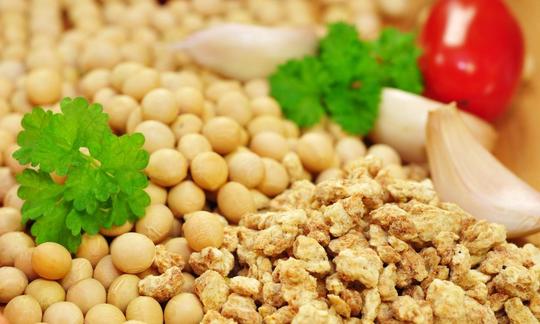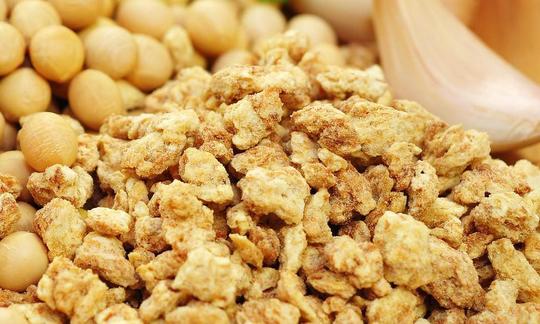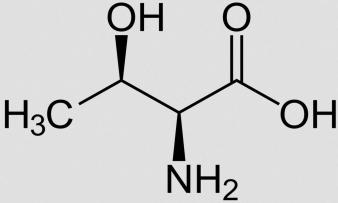Table of contents
Soy granules are made from heated and defatted soybeans and are therefore never raw. Organic soy cultivation is also much more environmentally friendly.
Use in the kitchen
Soy granules are a versatile ingredient. The granular form allows you to work very creatively with them. The countless 'minced meat recipes' offer good vegan inspiration. The meat classics, such as Bolognese sauce, meatloaf or meat patties for burgers, can easily be converted into a vegan soy granule recipe using soy granules. Traditional recipes for Hungarian stuffed peppers (also works well with zucchini), Turkish pizza, Mexican burritos or 'chili con carne' can also be converted into vegan dishes using the meat substitute.
Generally speaking, soybeans cannot be eaten raw. Due to the manufacturing process, soy granules are no longer a raw food product, but there are also manufacturing processes that use low levels of heat. These granules must be left to swell in hot water for 5 to 10 minutes, after which the water must be poured away. 2
Soya granules are also suitable for a 'Buddha Bowl'. To do this, you take a bowl and put together a colorful vegan dish: e.g. 1⁄4 salad (e.g. rocket, kale), 1⁄4 raw vegetables (e.g. cucumber, beetroot, pepper), 1⁄4 protein (e.g. soya granules in the form of small patties) and 1⁄4 complex carbohydrates /polysaccharides (e.g. quinoa, wholegrain rice). On top of that, you add a sauce made from avocados, sesame hummus or a Miang Kham sauce.
In general, soy granules are relatively tasteless (slightly bean-like taste) and therefore particularly suitable for absorbing the flavors of sauces and spices.
Vegan recipe for soy bolognese
Ingredients (for 4 people): 1 clove of garlic, 1 small onion, 1 teaspoon dried oregano, 400 g soy granules (organic), 3 small zucchini, 1 large carrot, 2 yellow peppers, 1 kg tomato sauce, 300 g wholemeal macaroni, salt,pepper, 2 tablespoons lemon juice, 4 tablespoons yeast flakes, 4 tablespoons freshly chopped parsley.
Alternatively, you could cook the pasta separately and use a raw tomato sauce.
Preparation: First, finely dice the onion and sauté in a large pot with 2 tablespoons of water until translucent. Add the tomato sauce. Set the stove to the lowest temperature and put a lid on the pot. To prepare the soy granules, boil hot water and prepare according to the preparation instructions on the packaging. Add the wholemeal pasta to the tomato sauce, making sure that the pasta is well covered with sauce. If necessary, top up the pot with a little water. Put the lid back on the pot.
While the pasta is cooking and the soy granules are swelling, cut the zucchini into bite-sized pieces. Grate the carrots and mix with lemon juice. Now strain the soy granules in a sieve and rinse briefly with water. Stir the pasta, add the soy granules and cover again with a lid. When the pasta is al dente, after about 5 minutes, you can add the garlic, pressed or finely chopped. Season with salt and pepper. As a final step, mix in the oregano, carrots, peppers and zucchini. Sprinkle each portion with 1 tablespoon of yeast flakes and parsley as needed.
Vegan recipes with soy granules can be found under the note: " Recipes that have the most of this ingredient ".
| Not only vegans or vegetarians should read this: Vegans often eat unhealthily. Avoidable nutritional errors. |
Purchasing - Storage
You can buy soya granules from major retailers such as Coop, Migros, Denner, Volg, Spar, Aldi, Lidl, Rewe, Edeka, Hofer, Billa etc. You are more likely to find organic quality soya granules in organic supermarkets such as Denn's Biomarkt and Alnatura. You can find out online or in a health food store where you can buy soya granules based on high-quality, preferably regional, organic soya beans.
Storage tips
Soya granules should be stored in a dry, airtight container. Under no circumstances should moisture be allowed to come into contact with them.
Ingredients - Nutritional values - Calories
Soya granules provide 356 kcal of energy per 100 g. Soya granules contain 7.5 g of fat per 100 g, of which 1.6 g are saturated fats. 100 g provide 29 g of carbohydrates with 15 g of fiber. Soya granules have particularly high nutritional values when it comes to proteins: 50 g/100 g. 4
The amino acid tryptophan is found in high quantities in soy granules: 100 g contain 0.62 g, which is 248% of the daily requirement. Shelled hemp seeds have a similar amount. Only a few plant-based foods exceed this value. These include dried porcini mushrooms (1.5 g/100g) and spirulina (0.93 g/100g). 4.5
Another important building block of proteins is the really essential amino acid threonine. This is also present in abundance at 2.1 g (226% of daily requirement). Dried dulse (ragweed) has a comparable value. Spirulina (3 g/100g) and brewer's yeast (2.7 g/100g) have a higher threonine content, but you eat much less of these ingredients; you absorb practically less threonine than with soy granules. 4.5
Folate, also known as folic acid, is present in high doses in soy granules (390 µg/100g). While 100 g of raw spinach covers around 100% of the daily requirement, 100 g of soy granules cover 195%. 4 Even more folate can be absorbed through brewer's yeast (3170 µg/100g) - 6.3 g/day can be sufficient here. 6
The complete ingredients of soy granules , the coverage of the daily requirement and comparison values with other ingredients can be found in our nutrient tables. In the article Nutrients explained you will get a detailed insight into the topic.
Effects on health
What is soy granulate? Soy granulate consists of soybeans that are heated or defatted to a greater or lesser extent using specific (usually proprietary) process steps, processed into a meat-like, airy mass and dehydrated. Compared to soybeans, soy granulate contains on average less fat and indigestible substances, but more protein. 24 Soy contains many amino acids that are important for the human organism. The amino acids contained in soy are of high quality and easily digestible (a similarity to animal products such as cow's milk or chicken eggs is often mentioned). Some authors refer to soy as a complete protein, others point out that it lacks methionine. 21, 31,32
Frequently discussed aspects of foods made from soybeans are the phytohormones (isoflavones), antinutrients and high-quality proteins they contain. Research is being carried out into positive and negative effects. Key topics are cancer, thyroid balance, feminization, cardiovascular disease and allergies. There are many studies on soy, but few clear results. Often, the consumption of soy shows no effect or a positive effect; at the same time, for example, studies on animals showed a negative effect. However, a positive influence of soy consumption is emerging, especially when cholesterol-containing or very fatty animal products are replaced with soy. 13,14
The most important secondary plant substances in soybeans are isoflavones (genistin, daidzin and glycitin). These substances have estrogenic and antiestrogenic activities. But also effects that are independent of this hormone. The composition differs depending on the preparation. Processing methods such as cooking, peeling and defatting reduce the isoflavone content. 1,25,27
A meta-analysis from 2022 showed that the current data suggests that women who consumed a lot of soy and isoflavones had a lower risk of developing breast cancer than women who did not have soy in their diet. 15 In another study of 300,000 women in China, researchers also concluded that moderate consumption of soy does not cause breast cancer and that increased intake could have a preventive effect against breast cancer. 16 But there are also contrary research results here: A second line of research focuses on the dangers of the estrogen-like effect of isoflavones. There are fears of negative effects on hormone-dependent cancers. 30
There are also recommendations for women with breast cancer to avoid soy because the healing effect of the usual breast cancer medications is reduced. Both substances, the medication and the soy isoflavones, compete for the same receptors. Caution is also advised in cases of hormonal thyroid problems. 18,20, 27,28
The hormonal influence of isoflavones on men also seems to be unclear. On the one hand, there is concern about fertility and feminization; on the other hand, researchers have found that these phytohormones have no negative influence on the male hormone balance. 28,29
Soy, like many other plants, contains antinutrients. Antinutritional ingredients (such as lectins, phytase and saponins) can limit the absorption of nutrients or even cause discomfort, but they also have positive effects on health. You can find out more about this under the ingredient soy milk.
So is soy granulate healthy? Antinutrients could help fight cancer, phytohormones can have an estrogenic or antiestrogenic effect, and the way soy is prepared changes the ingredients. The topic of soy remains controversial. 19 All in all, however, the positive effects of soy consumption are apparent. However, it is still unclear exactly which ingredients work in what way.
Soy products such as tofu, soy butter, soy nuts or some soy burgers (soy granules) are beneficial to health due to their high content of polyunsaturated fatty acids, fiber, vitamins and minerals and their low content of saturated fatty acids. The use of these and other soy foods as a substitute for foods high in animal protein, which contains saturated fats and cholesterol, may have a positive effect on cardiovascular health (cardiovascular disease or metabolic syndrome 12,26). However, the issue of soy remains dynamic and much research remains to be done. 1,26
Dangers - Intolerances - Side effects
Soybeans contain stachyose and raffinose, polysaccharides that we humans cannot digest directly. The bacteria in the large intestine convert these into sugar, which produces gases (flatulence). 33
Soy contains 15 proteins that can cause allergies and is one of the eight most common food allergens. 14% of people who suffer from a cow's milk allergy also have allergic reactions to soy. 31,28 Three in 1,000 adults suffer from it. 34 The symptoms of a soy allergy vary widely. In general, food allergy symptoms range from mild skin rashes to life-threatening systemic anaphylaxis and can be divided into four main types: dermatological (hives, local swelling, dermatitis and eczema), gastrointestinal (nausea, vomiting, diarrhea and abdominal pain), respiratory (runny nose, asthma and tightness in the throat) and systemic (anaphylactic shock, organ failure, cardiac arrhythmia and death). However, reports of fatal allergic reactions to soy are very rare (the victims also suffered from a severe peanut allergy and asthma). 9
As previously mentioned, caution is advised in cases of estrogen-dependent cancer and thyroid disease.
Ecological footprint - animal welfare
A study examined the ecological impacts and import dependency of protein-containing foods in Austria. In the combined assessment, domestic soy from organic farming was shown to be the most crisis-proof and ecologically best option. Organic pulses came in second place, followed by conventional soy. Animal products, particularly beef from conventional farming, brought up the rear. In order to ensure a nutritionally independent protein supply, the consumption of plant proteins is advantageous over animal proteins. And organic farming is, on average, better than conventional farming. 3
Consumption of plant-based protein as a meat analogue can effectively alleviate environmental and public health problems such as zoonotic and cardiovascular diseases, as well as animal welfare problems associated with the rearing and slaughter of animals. Plant-based meat substitutes that imitate the organoleptic properties of meat can help reduce the consumption of animal meat. They mainly consist of textured soy proteins. The development of textured soy proteins with the sensory properties of meat is a major challenge in improving their nutritional value, creating the right structure and removing the unpleasant flavors. 21
The ecological footprint of soya granulate (textured vegetable protein) is 1 kg CO 2 eq/kg. For comparison: for minced beef (organic) it is 15.1 kg CO 2 eq/kg. 35
The water footprint of soy depends heavily on the place and method of production (organic vs. conventional and irrigation vs. rainwater). One study showed that conventionally produced soybeans have a higher water footprint (between 2,145,000 L/kg and 3,172,000 L/kg) than organically produced soybeans (1,520,000 L/kg–2,024,000 L/kg). The study also found that soy milk and soy burgers (comparable to soy granules) use only 28% and 7% of the water needed to produce animal products compared to their animal equivalents. 17
In general, targeted purchasing decisions can contribute to a lower ecological footprint. 36 Consuming more regionally and organically produced soy and less meat contributes to less conventional soy being grown as animal feed and thus has an ecological leverage effect that has a positive impact on land use and animal welfare, among other things. 7
Soy consumption does not generally lead to negative land use changes (rainforest, savannahs). Conventional soy cultivation on a large scale is mainly intended for animal feed. More meat consumption also means more soy cultivation. 8,10, 7
For further information, see the other soy ingredients, e.g. cooked soybeans.
Animal welfare - species protection
Conventional soy cultivation is largely carried out in monocultures with the use of pesticides. The huge soy plantations often replace landscapes that are very rich in biodiversity. Soy cultivation therefore contributes to the loss of species. Soy as animal feed is primarily responsible for this. For our diet, it is advisable to buy organically produced soy or soy granules. 10
Worldwide occurrence - cultivation
Under the ingredient soybean you will find information on occurrence and cultivation.
Industrial production
When soybean proteins are processed at high temperature, shear force, pressure, and evaporation of moisture, the protein molecules melt and rearrange themselves, which can result in a textured, fibrous structure supported by the protein cross-links. 21
Defatted soy forms the basis of soy granules (defatted press cake from oil production). Some soy granule producers also work with concentrates - additional water is removed from the soy flour, which increases the protein content. In organic production, it is forbidden to use chemical defatting agents. The press cake is processed into protein flour. The protein content of the ground product is then determined and an attempt is made to concentrate the protein again. The mass is then pressed into the desired shape under pressure and at high temperature. The structure and shape of the soy granules are achieved using an extruder. During extrusion, the defatted soy mass is first compressed. The soy is then forced through a relatively small opening. The change in pressure produces a porous extrudate - the soy granules. Finally, the soy granules are dried. The exact procedure, form and consistency are based on many (company-owned) experiments. 2,11, 22
Research is still being carried out to reduce the bean taste in soy products. 21
Further information
The soybean ( Glycine max (L.) Merr.) is not only a protein-rich legume, but also one of the most important oil crops. 23
Alternative names
In the trade, soy granules are often referred to as soy mince. In scientific studies, the term textured soy protein is usually used. In English, it is called soy granules or 'textured soy protein'.
Other applications
Soy granules are also used in meat products as a filler or to improve quality.
Bibliography - 35 Sources
| 1. | Sacks FM, Lichtenstein A, Van Horn L, Harris W, Kris-Etherton P, Winston M. Soy protein, isoflavones, and cardiovascular health: an american heart association science advisory for professionals from the nutrition committee. Circulation. 21. Februar 2006;113(7):1034–44. |
| 2. | BIOSERVICE Zach GmbH.ORGANIC SOY GRANULES. |
| 3. | Zamecnik G, Lindenthal T, Rathmanner T & Himmelfreundpointner E. Krisensichere Ernährung-Bewertung ausgewählter eiweissreicher Lebensmittel hinsichtlich Risiken oder Potenziale einer nachhaltigen Ernährungssicherheit in Österreich. FiBL. 2023 |
| 4. | ÖNWT. Veganes BIO Soja Faschiertes (ÖNWT-GV H902900). dato Denkwerkzeuge in Zusammenarbeit mit dem Instituts für Ernährungswissenschaften der Universität Wien. |
| 6. | Instituts für Ernährungsinformation. DEBInet. Deutsche Ernährungsberatungs- & -informationsnetz. Bierhefe getrocknet |
| 7. | Sudarić A, Hrsg. Soybean for human consumption and animal feed [E-Book]. London: IntechOpen; 2020. |
| 8. | Ali W, Ahmad MM, Iftikhar F, Qureshi M & Ceyhan A. Nutritive potentials of Soybean and its significance for humans health and animal production: A Review. Eurasian Journal of Food Science and Technology. 2020; 4(1): 41-53. |
| 9. | Soy protein allergy: incidence and relative severity. The Journal of Nutrition. 1. Mai 2004;134(5):1213S-1219S. |
| 10. | WWF. Soja – die Nachfrage steigt. 23.08.2022. |
| 11. | Campbell MF. Processing and product characteristics for textured soy flours, concentrates and isolates. J Americ Oil Chem Soc. März 1981;58(3Part2):336–8. |
| 12. | George KS, Muñoz J, Akhavan NS, Foley EM, Siebert SC, Tenenbaum G, u. a. Is soy protein effective in reducing cholesterol and improving bone health? Food Funct. 2020;11(1):544–51. |
| 13. | Kumar P, Chatli MK, Mehta N, Singh P, Malav OP, Verma AK. Meat analogues: Health promising sustainable meat substitutes. Critical Reviews in Food Science and Nutrition. 24. März 2017;57(5):923–32. |
| 14. | Jooyandeh H. Soy products as healthy and functional foods. Middle-East Journal of Scientific Research. 2011; 7.1:71-80. |
| 15. | Boutas I, Kontogeorgi A, Dimitrakakis C, Kalantaridou SN. Soy isoflavones and breast cancer risk: a meta-analysis. In Vivo. 2022;36(2):556–62. |
| 16. | Wei Y, Lv J, Guo Y, Bian Z, Gao M, Du H, u. a. Soy intake and breast cancer risk: a prospective study of 300,000 Chinese women and a dose–response meta-analysis. Eur J Epidemiol. 1. Juni 2020;35(6):567–78. |
| 17. | Ercin AE, Aldaya MM, Hoekstra AY. The water footprint of soy milk and soy burger and equivalent animal products. Ecological Indicators. Juli 2012;18:392–402. |
| 18. | Zheng N, Hsieh E, Cai H, Shi L, Gu K, Zheng Y, u. a. Soy food consumption, exercise, and body mass index and osteoporotic fracture risk among breast cancer survivors: the shanghai breast cancer survival study. JNCI Cancer Spectrum. 1. Juni 2019;3(2):pkz017. |
| 19. | Deng K, Mo S, Liu X, Chen J, Zhang Q, Chen X, u. a. Soy foods might weaken the sensitivity of tamoxifen in premenopausal patients with lumina a subtype of breast cancer. Clinical Breast Cancer. April 2019;19(2):e337–42. |
| 20. | Wu AH, Pike MC, Williams LD, Spicer D, Tseng CC, Churchwell MI, u. a. Tamoxifen, soy, and lifestyle factors in asian american women with breast cancer. JCO. 20. Juli 2007;25(21):3024–30. |
| 21. | Yang L, Ying Z, Li H, Li J, Zhang T, Song Y, u. a. Extrusion production of textured soybean protein: The effect of energy input on structure and volatile beany flavor substances. Food Chemistry. März 2023;405:134728. |
| 22. | Bundesanstalt für Landwirtschaft und Ernährung. Ökolandbau.de: Das Informationsportal. Extrusion für die Herstellung pflanzlicher Proteinprodukte. 2021. |
| 23. | Singh G. The soybean: botany, production and uses. CABI; 2010. 508 S. |
| 24. | Erickson DR. Practical handbook of soybean processing and utilization. Elsevier; 2015. 594 S. |
| 25. | Toda T, Sakamoto A, Takayanagi T, Yokotsuka K. Changes in isoflavone compositions of soybean foods during cooking process. Food Science and Technology Research. 2000;6(4):314–9. |
| 26. | Yamagata K, Yamori Y. Potential effects of soy isoflavones on the prevention of metabolic syndrome. Molecules. 27. September 2021;26(19):5863. |
| 27. | Bensaada S, Raymond I, Breton M, Pellegrin I, Viallard JF, Bennetau-Pelissero C. Development of an assay for soy isoflavones in women’s hair. Nutrients. Januar 2022;14(17):3619. |
| 28. | Mollakhalili-Meybodi N, Arab M, Zare L. Harmful compounds of soy milk: characterization and reduction strategies. J Food Sci Technol. Oktober 2022;59(10):3723–32. |
| 29. | Reed KE, Camargo J, Hamilton-Reeves J, Kurzer M, Messina M. Neither soy nor isoflavone intake affects male reproductive hormones: An expanded and updated meta-analysis of clinical studies. Reproductive Toxicology. März 2021;100:60–7. |
| 30. | C. Douglas C, A. Johnson S, H. Arjmandi B. Soy and its isoflavones: the truth behind the science in breast cancer. Anti-Cancer Agents in Medicinal Chemistry- Anti-Cancer Agents). 1. Oktober 2013;13(8):1178–87. |
| 31. | Silva ARA, Silva MMN, Ribeiro BD. Health issues and technological aspects of plant-based alternative milk. Food Research International. Mai 2020;131:108972. |
| 32. | Hoffman JR, Falvo MJ. Protein – which is best? J Sports Sci Med. 1. September 2004;3(3):118–30. |
| 33. | Kumari M, Kokkiligadda A, Dasriya V, Naithani H. Functional relevance and health benefits of soymilk fermented by lactic acid bacteria. J Appl Microbiol. Juli 2022;133(1):104–19. |
| 34. | Messina M, Duncan A, Messina V, Lynch H, Kiel J, Erdman JW. The health effects of soy: A reference guide for health professionals. Front Nutr. 11. August 2022;9:970364. |
| 35. | Reinhardt G, Gärtner S, Wagner T. Ökologische Fussabdrücke von Lebensmitteln und Gerichten in Deutschland. Institut für Energie- und Umweltforschung Heidelberg. 2020. |
| 36. | Zhiyenbek A et al. Ökobilanzierung Früchte-und Gemüseproduktion." Nachhaltiger Konsum ETHZ. 2016; 33. |












Comments